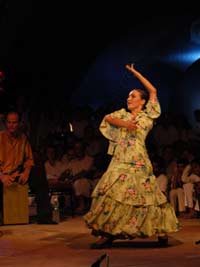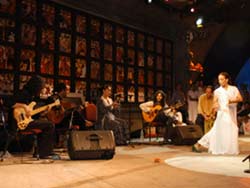Flamenco for Amma

Flamenco dancer
As Amma gave darshan to thousands on the evening of 26 Septmeber, Amma’s children got to experience the vibrant and emotional expression of the Carvajales flamenco dance troupe. The dance troupe from Spain consists of musicians with guitars and percussion, a female singer, and a female dancer. While one thinks of a flamenco dancer as being highly energetic, watching the musicians and the singer gives a broader perspective to this art form. All members of this group perform intensely and skilfully. The music, the voice, and the percussive beat of the dancer’s feet penetrate deeply into the viewer’s body. Perhaps this is why the dance presented tonight is called “cante hondo,” deepest song.
Flamenco dance comes from Andalucia, the southernmost province of Spain. While usually associated with the Gypsy communities who came to Spain from Asia, it was also certainly influenced by popular Andalucian folk songs and dances and the North African Moorish Muslim culture. During the late 19th century, Flamenco dancing reached its peak. It was then, and still is the most popular dance tradition in Spain. –Triguna Besse
The Heart of Flamenco
 When Carolina, David and Rafael were performing in southern Spain at Laschumbear, a recognized flamenco dance center, they had no idea that a visit to India was in the making. A friend had recently learned of Amma’s birthday celebration and contacted them to see if they would be open to representing Spain in the cultural program. Even though they had never met Amma, they had the faith to begin plans for this exciting opportunity.
When Carolina, David and Rafael were performing in southern Spain at Laschumbear, a recognized flamenco dance center, they had no idea that a visit to India was in the making. A friend had recently learned of Amma’s birthday celebration and contacted them to see if they would be open to representing Spain in the cultural program. Even though they had never met Amma, they had the faith to begin plans for this exciting opportunity.
After arriving in India , they traveled straight to Amritapuri to meet Amma for the first time and to receive darshan. Then after some travel in South India they settled into their intense daily six hour schedule of practice at the ashram. They could feel the excitement welling up as performers began arriving daily to prepare for Amma.
The troupe consists of six members who use the elements of percussion, song, guitar, and dance. Rafael plays a wooden instrument called a cajon originating from Bolivia. David plays guitar and Carolina, the solo dancer, has trained in flamenco for nearly 20 years. The other performers include more percussion and song.
Although the stylized dance, song, and music form of flamenco is thought to have originated in Spain, it emerged from the Gypsy culture. Centuries ago gypsies migrated from India making their final destination to southern Spain at Andalucia where the hot climate promoted intense feeling, force and depth into this unique art. Because of the many hardships due to discrimination against Gypsies, they found an emotional outlet through flamenco. The heart of flamenco is the passionate and fiery nature expressed through rhythms and movement. Two main types of flamenco exist: pure and mixture (European influenced). Over 50 different rhythms called palos are expressed using footwork, claps ,guitar, song, and dance.
The dancer choreographs a routine to composed music, yet there is ample opportunity for improvisation when the performers intuitively sense each others’ need and direction to extend a further movement or rhythm. As Carolina pointed out, “Explanations cannot express the magic that happens. The universal dimension of music takes over.” If you think about it, flamenco is Amma’s magic at work!
Submitted by Sharada












